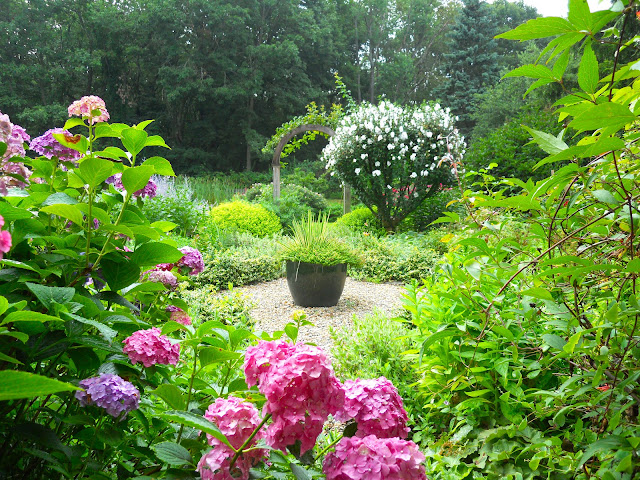Some of my readers may recall that last winter I shared a few of my favorite garden plants in a post entitled "Top Ten". Continuing the tradition, I'm including another group of indispensable selections. They may not be the most exotic subjects, but they have all proven their mettle. This year's list includes perennials, shrubs and vines all of which I have used both in my garden and in designs for my clients. Without exception they have performed superbly with a minimum of care.
1) Deutzia Nikko
This small, spring blooming bush covers itself with pure white flowers in late May or early June. I often use it in in large groups or as an edging plant in full sun. It also mixes quite well with perennials. There is a larger version as well, but I prefer this petite selection.
2) Clematis Montana Rubens
Although I'm embarrassed to admit that I haven't had much luck with large-flowered clematis, Montana Rubens never disappoints. Here I'm growing it over my roof, where its pink blooms put on a wonderful display that compliments the last of the daffodils. This is a sturdy vine that requires some space in either part shade or full sun. At my mother's house it covers a large arbor beneath a old, sugar maple, which is a testament to it's tenacity. The new foliage and stems have a lovely reddish caste and the flowers smell faintly of vanilla.
3) Echinacea Hot Papaya
Not that long ago Echinaceas came only in pink or white single flowers like large daisies. Recently,however, new colors and flower forms have become available. I've tried a number of these introductions only to be disappointed by their performance and longevity. Hot Papaya is an exception. If planted in full sun the plants bloom for months. I use this variety in my hot colored garden where its bright reddish-orange flowers make a dramatic display that is anything but demure. Unfortunately groundhogs find the flowers as irresistible as I do.
4) Digitalis Ambigua
Most foxgloves are biennials that form a roseate of leaves their first year and flower spikes the second. After blooming the plants set seed and die. The yellow flowered Digitalis Ambigua is a relatively long-lived exception. In full sun or part shade the plants, which have few pests and are ignored by deer, flower heavily in early summer and often bloom repeatedly until frost. They are also prolific self-seeders, increasing their numbers at a bountiful rate. They make a wonderful addition to the perennial garden or more naturalized plantings like the one pictured below, which I created for a client a few years ago.
5) Hydrangea Coerulea Lace
Many wonderful new hydrangea varieties have appeared in recent years but this old-fashioned beauty is still one of my favorites. It blooms abundantly in full to part shade and makes a terrific companion for ferns, hostas and astilbes. Unlike other hydrangeas it never fails to bloom and the flower color isn't affected by soil acidity. In the picture below I've paired it with Hydrangea Quercifolia (another old-time favorite) and hostas in my Blue and White garden.
6) Ligularia The Rocket
Ligularias form a wonderful group of shade loving plants and at almost four feet tall, The Rocket, makes a bold statement in the garden. Without ample moisture the leaves wilt when struck by the sun, but soon recover when shade is reestablished.
7) Hosta Sum and Substance
The large, crinkled, chartreuse leaves pictured above belong to Hosta Sum and Substance. While there are countless wonderful hosta varieties available today, this variety remains one of my favorites. Over time it takes on almost shrub-like proportions and the foliage becomes increasingly textured as the plants mature. Tall stems sporting blue flowers crown the plants in late summer, but this variety is grown primarily for its dramatic leaves, which are impervious to snails and slugs. As shown here, If given ample moisture this hosta will tolerate full sun, but it prefers a sheltered position and makes a superb addition to the shade garden.
8) Cornus Ivory Halo
A smaller version of the more common variegated red twig dogwood, Ivory Halo makes a nice compact addition to the shrub border. Its leaves retain their silver edging all summer and in winter its brilliant red stems make a bold statement against the snow. It seems equally happy in sun or part shade and thrives in damp soil. As pictured below I have used it to great effect en masse in wetland gardens, where it flourishes even when subjected to periodic flooding.
9) Clematis Maximowicziana (Sweet Autumn Clematis)
The mass of small white flowers completely covering the arbor above belong to the Sweet Autumn Clematis. This somewhat rampant vine is a late-season workhorse and though its flowering is brief, the blossoms come at time when little else is in bloom. Equally at home in sun or part shade it will scramble over walls, along fences, up trees or across a pergola. Some pruning might be required to keep it in bounds, but the wealth of fragrant flowers is well worth the effort.
10) Rosa Peach Drift
The Drift series of roses form a relatively new addition to the landscape rose category. In addition to peach they come in pale pink, white and red. They are virtually trouble free and at barely two feet tall and wide can be planted in small spaces where larger rose bushes would be problematic. Because they bloom from early summer until frost and are incredibly sturdy they have quickly become one of my favorite landscape roses. Planted en masse they make an unbeatable addition to the garden or shrub border.
Well there you have it, ten more of my favorites, both new and old. Perhaps you'll find a home for one or more in your garden this spring.
Happy New Year!


















































